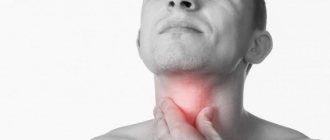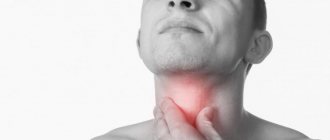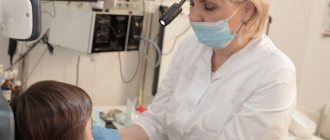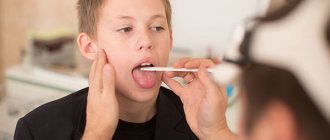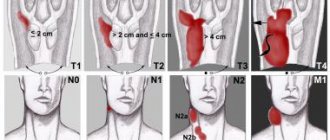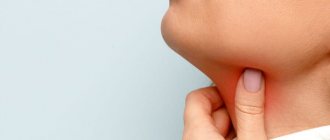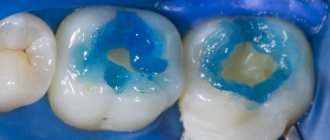The structure of the larynx, its role in voice formation
Slide 1
Voice formation Voice formation
Slide 2
2 Vocal folds and glottis Vocal folds (aka vocal cords) begin on either side of the arytenoid cartilages and are attached to the inner surface of the thyroid cartilage. Above the vocal folds there are more poorly developed folds of the vestibule. The void between the vocal folds and the folds of the vestibule is called the laryngeal ventricle. The glottis is the space between the vocal folds that remains for air to pass through. This gap is constantly changing - from a narrow gap during the utterance of sounds to the shape of a triangle during silence. Normally, during breathing, the lateral sides of the triangle of the vocal folds have a whitish color, and in the posterior section the medial surfaces of the arytenoid cartilages are visible. The base of the triangle is the posterior wall of the larynx, and the apex is called the anterior commissure. Like the vocal folds, the folds of the vestibule also form a fissure. All of the above together forms the vocal apparatus.
Slide 3
Location
Slide 4
The role of the larynx in voice formation 4 The voice is formed in the larynx. This process is called phonation. During quiet breathing, the vocal cords are relaxed and form a wide triangle that does not interfere with the passage of air. When a person is about to utter a sound, the vocal cords tense, move and form a narrow gap. A stream of air exhaled from the lungs passes through the closed vocal folds and causes them to vibrate. As a result, a weak sound is generated, which is amplified in the cavities of the nose, pharynx and mouth, which in this case act as a resonator. There, during the articulatory movements of the lips, tongue, cheeks and jaw, certain sounds are formed that make up coherent speech. The strength of the voice depends on the pressure of the air stream, the elasticity of the vocal cords and the amplitude of their vibrations; the length and frequency of these vibrations determine the pitch of the voice
Slide 5
References Samusev R.P. Atlas of human anatomy / R.P. Samusev, V.Ya. Lipchenko. - M., 2002. Gracheva M.S. Morphology and functional significance of the nervous apparatus of the larynx. - M., 1956. Palchun V.T., Magomedov M.M., Luchikhin L.A. Otorhinolaryngology. Textbook for universities. 2nd ed., rev. and additional M.: GEOTAR-Media, 2008 Palchun V.T., Kryukov A.I. Otorhinolaryngology: A guide for doctors. M.: Medicine, 2001. Vasilenko Yu.S. Voice. Phoniatric aspects / Yu.S. Vasilenko. – M.: Energoizdat, 2002. Babiyak V.I. Otorhinolaryngology. - RF: St. Petersburg, 2009 Yakovlev M., Drozdova M. Complete course in 3 days. Human anatomy Shimkevich V. M.,. Thyroid gland, anatomy / Encyclopedic Dictionary of Brockhaus and Efron Shimkevich V. M.,. Jugular veins / Encyclopedic Dictionary of Brockhaus and Efron Atlas of Human Anatomy Sinelnikov R.D. and others. Volume 3 Gellat P.P. Breathing and position of the larynx. 2 lectures on physiology Muzehold A. Acoustics and mechanics of the human vocal organ
Anatomy of the Human Laryngeal Cavity - information:
The cavity of the larynx, cavitas laryngis, opens with an opening - the entrance to the larynx, aditus laryngis. It is bounded in front by the free edge of the epiglottis, in the back by the apices of the arytenoid cartilages together with the fold of the mucous membrane between them, plica interarytenoidea, on the sides by the folds of the mucous membrane stretched between the epiglottis and the arytenoid cartilages, plicae aryepiglotticae. On the sides of the latter there are pear-shaped depressions in the wall of the pharynx, recessus piriformes.
The cavity of the larynx itself is shaped like an hourglass: in the middle section it is narrowed, widened upward and downward. The upper expanded section of the laryngeal cavity is called the vestibule of the larynx, vestibulum laryngis . The vestibule extends from the entrance to the larynx to a paired fold of the mucous membrane located on the side wall of the cavity and called plica vestibularis; the thickness of the latter contains lig. vestibulare.
The walls of the vestibule are: in front - the dorsal surface of the epiglottis, in the back - the upper parts of the arytenoid cartilages and plica interarytenoidea, on the sides - a paired elastic membrane stretching from the plica vestibularis to the plica aryepiglottica and called membrana fibroelastica laryngis. The most complex structure is the middle, narrowed, section of the laryngeal cavity - the vocal apparatus itself, glottis. It is delimited from the upper and lower sections by two pairs of folds of the mucous membrane located on the lateral walls of the larynx. The upper fold is the already mentioned paired plica vestibularis. The free edges of the folds limit the unpaired, rather wide fissure of the vestibule, rima vestibuli.
The lower fold, vocal fold, plica vocalis, protrudes into the cavity larger than the upper one and contains the vocal cord, lig. vocale, vocal muscle, m. vocalis. The depression between the plica vestibularis and plica vocalis is called the ventricle of the larynx, ventriculus laryngis. A sagittally located glottis, rima glottidis, is formed between both plicae vocales. This gap is the narrowest part of the laryngeal cavity. It distinguishes between the large anterior section, located between the ligaments themselves and called the intermembranous part, pars intermembranacea, and the smaller posterior one, located between the vocal processes, processus vocalis, of the arytenoid cartilages - the intercartilaginous part, pars intercartilaginea.
The lower expanded section of the larynx, cavitas infraglottica, gradually narrows downwards and passes into the trachea. In a living person, during laryngoscopy (examination of the larynx using a laryngeal mirror), you can see the shape of the glottis and its changes. During the act of phonation (sound formation), the pars intermembranacea appears as a narrow slit, the pars intercartilaginea has the outline of a small triangle; with quiet breathing, the pars intermembranacea expands and the entire glottis takes the shape of a triangle, the base of which is located between the arytenoid cartilages.
The mucous membrane of the larynx looks smooth and has a uniform pink color, without local changes in relief and mobility. In the area of the vocal cords it has a pink color, in the area of lig. vestibulare - reddish. The mucous membrane of the larynx above the vocal cords is extremely sensitive: when foreign bodies enter here, a reaction is immediately observed in the form of a severe cough.
Sound formation occurs during exhalation. The reason for the formation of voice is the vibration of the vocal cords, which do not vibrate passively under the influence of air current, but due to a close relationship with mm. vocales, which contract actively under the influence of rhythmic impulses coming along the nerves from the centers of the brain with a sound frequency. The sound generated by the vocal cords, in addition to the main tone, contains a number of overtones. Nevertheless, this “connective” sound is still completely different from the sounds of a living voice: the voice acquires its natural human timbre only thanks to a system of resonators.
Since nature is a very economical builder, the role of resonators is performed by the various air cavities of the respiratory tract surrounding the vocal cords. The most important resonators are the pharynx and oral cavity.
Vessels and nerves. Arteries of the larynx - aa. laryngea sup. et inf. (from aa. thyroideae sup. et inf.). Venous outflow through the plexuses into the veins of the same name. Lymphatic drainage into the nodi lymphatici cervicales profundi and into the preglottic nodes. Nerves - nn. laryngeus sup. et. inf. (from n. vagi) and truncus sympathicus.
content .. 121 122 123 124 125 126 127 128 129 130 ..Larynx (human anatomy)
Larynx
, larynx, a hollow organ of complex structure, which at the top is suspended from the hyoid bone, and at the bottom passes into the trachea. The upper part of the larynx opens into the oral part of the pharynx. Behind the larynx is the laryngeal part of the pharynx. Being an organ of voice formation, the larynx has: 1) a cartilaginous skeleton, consisting of cartilages that articulate with each other; 2) muscles that determine the movement of cartilage and tension of the vocal cord; 3) mucous membrane.
Laryngeal cartilages
. The cartilaginous skeleton of the larynx is represented by 3 unpaired cartilages - cricoid, thyroid and epiglottis and 3 paired - arytenoid, corniculate and wedge-shaped (Fig. 123).
Fig. 123. Cartilages, ligaments and joints of the larynx. a — front view: 1 — hyoid bone; 2 - granular cartilage; 3 - upper horn of the thyroid cartilage; 4 - left plate of the thyroid cartilage; 5 - lower horn of the thyroid cartilage; 6 - arch of cricoid cartilage; 7 - tracheal cartilage; 8 - annular ligaments of the trachea; 9 - cricothyroid joint; 10 - cricothyroid ligament; 11 - superior thyroid notch; 12 - thyroid-hyoid membrane; 13 - median thyroid-hyoid ligament; 14 - thyroid-hyoid ligament. b — rear view: 1 — epiglottis; 2 - greater horn of the hyoid bone; 3 - granular cartilage; 4 - upper horn of the thyroid cartilage; 5 - right plate of the thyroid cartilage; 6 - arytenoid cartilage; 7, 14 - right and left crico-arytenoid joints; 8, 12 - right and left cricothyroid joints; 9 - tracheal cartilage; 10 - membranous wall of the trachea; 11 — plate of the cricoid cartilage; 13 - lower horn of the thyroid cartilage; 15 - muscular process of the arytenoid cartilage; 16 - vocal process of the arytenoid cartilage; 17 - thyroid-epiglottic ligament; 18 - corniculate cartilage; 19 - thyroid-hyoid ligament; 20 - thyroid-hyoid membrane
1. Cricoid cartilage
, cartilage cricoidea, hyaline, forms the base of the larynx. It is similar in shape to a ring and consists of a plate, lamina cartilaginis cricoideae, facing posteriorly, and an arch, arcus cartilaginis cricoideae, facing anteriorly. On the upper outer corners of the plate there are arytenoid articular surfaces, fades articulares arytenoideae for articulation with the arytenoid cartilages, and on the posterolateral surfaces of the arch there are thyroid articular surfaces, fades articulares thyreoideae.
2. Thyroid cartilage
, cartilago thyreoidea, hyaline, the largest, consists of two plates - right and left, laminae dextra et sinistra, connecting in front at an angle of 60-70°. In the middle of the upper and lower edges of the cartilage there are notches: the upper one, incisura thyreoidea superior, and the lower one, incisura thyreoidea inferior. The thickened posterior edge of each plate continues up and down with the formation of protrusions - the upper and lower horns, cornua superiores et inferiores. The lower horns have articular surfaces from the inside for articulation with the cricoid cartilage. On the outer surface of both plates, an oblique line, linea obliqua, runs from the upper horn down and anteriorly, the place of attachment of the sternothyroid and hyoid muscles. The connection of the plates at the apex of the superior notch forms the laryngeal protrusion, prominentia laryngea, which is better expressed in men.
3. Epiglottis
, epiglottis, consists of elastic cartilage and has a leaf-like shape. Its anterior surface, facing the base of the tongue, is connected to the body and horns of the hyoid bone, and the lateral edges are connected to the arytenoid cartilages. The posterior surface faces the entrance to the larynx. Below, the epiglottis narrows into a stalk, petiolus epiglottidis, which is attached to the inner surface of the upper edge of the thyroid cartilage. The lower portion of the dorsal surface of the epiglottis forms a posterior projection called the tubercle, tuberculum epiglotticum.
4. Arytenoid cartilages
, cartilagines arytenoideae, elastic, paired, similar in shape to a triangular pyramid, the base of which, basis, is connected to the upper-posterior edge of the plate of the cricoid cartilage, and the apex, apex, is directed upward. There are three surfaces - anterolateral, medial and posterior. The medial surface is the smallest, the posterior one is concave, and the anterolateral surface is the widest. An arched ridge, starting from the mound, colliculus, runs along it, dividing this surface into two pits: the upper - triangular, fovea triangularis, and the lower - oblong, fovea oblonga, to which m. vocalis. At the base of the cartilage there are two processes: the lateral - muscular, processus muscularis, on which the muscles are attached, and the anterior - vocal, processus vocalis, where the vocal cord is attached.
5. Corniculate cartilages
, cartilagines corniculatae, elastic, paired, located on the tops of the arytenoid cartilages, which have a conical shape.
6. Wedge-shaped cartilages
, cartilagines cuneiformes, paired, rod-shaped, lie in the aryepiglottic ligament.
Articulations of cartilages and ligaments of the larynx. A number of joints are formed between the cartilages of the larynx, causing their mobility and, consequently, a change in the tension of the vocal cord (see Fig. 123).
1. Cricothyroid joint
, articulatio cricothyreoidea, paired, between the lower horns of the thyroid cartilage and the thyroid articular surfaces of the cricoid. Movements in the joint cause movement of the thyroid cartilage in relation to the arytenoids and tension or relaxation of the vocal cords.
2. Crico-arytenoid joint
, articulatio cricoarytenoidea, paired, between the articular surfaces of the arytenoid cartilages and the cricoid. Movements in the joint occur around a vertical axis, which is accompanied by rotation of the arytenoid cartilages, moving the vocal processes away or bringing them closer together. In addition, there may be sliding of the arytenoid cartilages towards each other and vice versa. In addition to the articulations, there are arycornoid synchondroses, synchondroses arycorniculatae, connections of the cornicular cartilages with the apices of the arytenoids.
The connection of cartilage, as well as the larynx with neighboring organs, is also accomplished with the help of the following membranes and ligaments.
1. Thyrohyoid membrane
, membrana thyreohyoidea, formed by the unpaired median thyrohyoid ligament, lig. thyreohyoideum medianum, stretching between the upper edge of the thyroid cartilage in the area of the superior notch and the body of the hyoid bone, and the paired lateral thyrohyoid ligaments, ligg. thyreohyoidei laterales, running between the upper edge of the plates of the thyroid cartilage, including the superior horns, and the greater horns of the hyoid bone. In their thickness lies granular cartilage, cartilago triticea.
2. Hypoepiglottic ligament
, lig. hyoepiglotticum. - between the middle of the anterior surface of the epiglottis, the body and horns of the hyoid bone.
3. Thyroepiglottic ligament
, lig. thyreoepiglotticum, - between the thyroid cartilage and the stem of the epiglottis.
4. Cricothyroid ligament
, lig. cricothyreoideum, - between the arch of the cricoid cartilage and the inferior notch of the thyroid cartilage. The ligament consists of elastic fibers.
5. Cricotracheal ligament
, lig. cricotracheale, - between the lower edge of the cricoid cartilage arch and the first cartilaginous ring of the trachea.
6. Cricopharyngeal ligament
, lig. cricopharyngeum, - between the lateral surface of the plate of the cricoid cartilage and the pharynx.
7. Posterior cricoarytenoid ligaments
, ligg. cricoarytenoidei posteriores, paired, - between the cricoid and arytenoid cartilages. It is a continuation in the lateral direction of the cricothyroid ligament.
8. Vocal cords
, ligg. vocales, paired, between the vocal processes of the arytenoid cartilages and the middle of the inner surface of the thyroid. Ligaments consist of elastic fibers. Both ligaments limit the glottis, rima glottidis.
9. vestibular ligaments
, ligg. vestibulares, paired, are located above the vocal cords in the thickness of the fold of the same name.
Muscles of the larynx. The muscles of the larynx are functionally divided into: 1) narrowing the laryngeal cavity or glottis (constrictors); 2) expanding the cavity and glottis (dilators); 3) changing the tension of the vocal cords (Fig. 124).
Rice. 124. Muscles of the larynx. a — rear view: 1 — epiglottis; 2 - greater horn of the hyoid bone; 3 - thyrohyoid ligament; 4 - hyoid-hyoid membrane; 5 - upper horn of the thyroid cartilage; 6, 8 - aryepiglottic muscle; 7 - arytenoid cartilage; 9 - transverse arytenoid muscle; 10 - muscular process of the arytenoid cartilage; 11 - cricoid cartilage; 12 - lower horn of the thyroid cartilage; 13 - posterior cricoarytenoid muscle; 14 - trachea. b — side view: 1 — epiglottis; 2 - thyroid cartilage (dissected); 3 - thyroid-arytenoid muscle; 4 - lateral cricoarytenoid muscle; 5 - cricothyroid ligament; 6 - cricoid cartilage; 7 - trachea; 8 - arytenoid articular surface; 9 - posterior cricoarytenoid muscle; 10 - muscular process of the arytenoid cartilage; 11 - aryepiglottic muscle; 12 - corniculate cartilage
Constrictor muscles
.
1. Lateral cricoarytenoid muscle
, m. cricoarytenoideus lateralis, paired, begins on the arch of the cricoid cartilage and attaches to the muscular process of the arytenoid. When contracted, it pulls the muscular process forward, turning the vocal process and bringing the vocal cords closer together.
2. Thyroarytenoid muscle
, m. thyreoarytenoideus, steam room, originates from the inner surface of the plates of the thyroid cartilage and stretches up and back to the muscular process of the arytenoid. With simultaneous muscle contraction, the cavity of the larynx above the vocal cords narrows.
3. Transverse arytenoid muscle
, m. arytenoideus transversus, unpaired, is located between the arytenoid cartilages and, when contracted, narrows the glottis at the back, bringing the arytenoid cartilages closer together.
4. Oblique arytenoid muscle
, m. arytenoideus obliquus, paired, begins on the muscular process of the arytenoid cartilage, goes obliquely upward and attaches to the apex of the opposite arytenoid cartilage. It functions simultaneously with the previous muscle, causing a narrowing of the glottis at the back.
5. Arepiglottis muscle
, m. aryepiglotticus, paired, originates at the apex of the arytenoid cartilage next to the previous one, goes up and forward in the thickness of the plica aryepiglottica and attaches to the lateral edge of the epiglottis. It narrows the entrance to the larynx and pulls the epiglottis down.
Dilator muscles
.
1. Thyroepiglottic muscle
, m. thyreoepiglotticus, paired, starts from the inner surface of the plate of the thyroid cartilage and is attached to the edge of the epiglottis, partially passing into the aryepiglottic fold. Expands the entrance to the larynx and its vestibule.
2. Posterior cricoarytenoid muscle
, m. cricoarytenoideus posterior, steam room, originates on the posterior surface of the plate of the cricoid cartilage and attaches to the muscular process of the arytenoid. During contraction, the muscular process moves posteriorly and medially, as a result of which the vocal process turns laterally and upward, which causes an expansion of the glottis.
Muscles that change vocal cord tension
.
1. Vocal muscle
, m. vocalis, paired, begins in front on the inner surface of the thyroid cartilage in the middle of the inferior notch and is attached to the vocal process. The medial edge of the vocal muscle is fused with the vocal cord, and the lateral edge is adjacent to the thyroarytenoid muscle. Relaxes the vocal cords and narrows the glottis.
2. Cricothyroid muscle
, m. cricothyreoideus, paired, originates from the middle of the cricoid cartilage arch, goes laterally and upward, attaches to the lower edge of the thyroid cartilage and its lower horn. During contraction, the thyroid cartilage is pulled forward, causing tension in the vocal cords and narrowing of the glottis.
Laryngeal wall
. The wall of the larynx is formed by: 1) its cartilage, united into a tube through ligaments and muscles; 2) fibrous-elastic membrane; 3) mucous membrane; 4) outer connective tissue membrane.
1. Cartilage and muscles
larynx are described above.
2. Fibrous-elastic membrane of the larynx
, membrana fibroelastica laryngis, is a layer of fibro-elastic connective tissue lying directly under the mucous membrane of the larynx. On the inner surface of the thyroid cartilage, between its inferior notch and the vocal processes of the arytenoids and the upper edge of the cricoid cartilage arch, there are dense bundles of elastic fibers that form an elastic cone, conus elasticus.
3. Mucous membrane
, is lined, with the exception of its vocal folds, by multirow ciliated epithelium. The vocal folds are covered with stratified squamous epithelium. The epiglottis is lined with multirow squamous epithelium, since here the mucous membrane of the larynx passes into the mucous membrane of the digestive tract.
The proper layer of the mucous membrane is represented by unformed connective tissue with many elastic fibers. It is tightly connected to the fibroelastic membranes of the larynx and contains mixed laryngeal glands, glandulae laryngeae, and laryngeal lymphatic follicles, folliculi lymphatici laryngei. The mucous membrane limits the cavity of the larynx.
4. Outer connective tissue membrane
, tunica adventitia, surrounds the cartilages of the larynx. It contains many elastic fibers and forms a fascial cover around the larynx (visceral layer of the fourth fascia of the neck (see section Elements of neck topography, this edition).
Laryngeal cavity
. The cavity of the larynx, cavum laryngis, is a tube with two expansions and one narrowing in the middle. At the top, the laryngeal cavity opens with the entrance to the larynx, aditus laryngis, which is limited in front by the epiglottis, behind by the tips of the arytenoid cartilages and on the sides by the aryepiglottic folds, plicae aryepiglotticae, formed by the mucous membrane.
The upper, expanded, section of the larynx forms its vestibule, vestibulum laryngis, which is located in the area from the entrance to the larynx to the vestibular folds of the mucous membrane, plicae vestibulares, limiting the fissure of the vestibule, rima vestibuli. The mucous membrane of the vestibule of the larynx is very sensitive and its irritation is accompanied by a reflex cough.
The middle, narrowed, section of the larynx extends from the vestibule fissure to the glottis, rima glottidis, formed by two vocal folds, plicae vocales. The vocal folds contain vocal cords and muscles. Between the vestibular and vocal folds, a depression is formed on each side - the ventricle of the larynx, ventriculus laryngis. The glottis is the narrowest part of the larynx. It has two sections, the intermembranous, pars intermembranacea, formed by the vocal folds, and the intercartilaginous, pars inter cartilaginea, limited by the vocal processes of the arytenoid cartilages. The vibration of the vocal cords during the passage of a stream of air during exhalation occurs under the influence of the muscles of the larynx, which tense and relax the vocal cords. Vibration of the ligaments causes the appearance of oscillatory waves of exhaled air, causing the appearance of sound. The sound arising in the larynx is amplified and acquires additional color under the influence of the resonator system, which includes the upper respiratory tract, oral cavity and paranasal sinuses.
The lower, expanded section of the larynx is the subglottic cavity, cavum infraglotticum, tapering downwards and passes into the trachea.
In a living person, the laryngeal cavity can be examined using a laryngoscope (laryngoscopy). During laryngoscopy, the vestibular and vocal folds, the mucous membrane of the larynx, and the condition of the glottis are visible. When breathing, the glottis is widened, and when sound is produced, it is narrowed or even closed. The vocal folds are pink, the vestibular folds are reddish. The surface of the mucous membrane is smooth and pink.
Topography of the larynx
. The larynx is located at the level of the IV-VI cervical vertebrae. Behind the larynx is the laryngeal part of the pharynx, on the sides are the neurovascular bundles of the neck and the lobes of the thyroid gland. The front of the larynx is covered with muscles starting on the hyoid bone.
Age-related features of the larynx
. In newborns, the larynx is short and wide. It is located 3 vertebrae higher than in adults, and reaches its final position by the age of 13. Corniculate cartilages are absent. The entrance to the larynx is wide. Thyrohyoid ligaments are absent. In subsequent years, the larynx increases in size. By the age of 7, all anatomical formations of the larynx appear. Boys aged 12-15 experience particularly significant growth of the larynx. Its cavity increases, the vocal cords lengthen, and therefore the voice changes (voice mutation). In girls, the growth of the larynx occurs more gradually.
X-ray anatomy of the larynx
. During an X-ray examination in the lateral projection, due to the presence of an air column, the contours of the anterior and posterior walls of the larynx and pharynx, the ventricles of the larynx, the epiglottis, the shadows of the vestibular and vocal cords, the upper and posterior contours of the cricoid cartilage, and the trachea are visible. The sagittal projection reveals the lateral walls of the larynx. A slightly contoured shadow of the epiglottis, shadows of the aryepiglottic folds, vestibular and vocal folds, and the ventricles of the larynx are visible.
Blood supply to the larynx occurs through the superior and inferior laryngeal arteries (from the corresponding thyroid arteries). Veins are formed from the venous plexuses of the mucous membrane and drain blood into the veins of the same name as the arteries, which flow into the thyroid.
Lymphatic vessels carry lymph to the deep cervical nodes.
The vagus nerves send the superior and recurrent laryngeal nerves to the larynx. Sympathetic fibers come from the cervical nodes of the sympathetic trunk.
content .. 121 122 123 124 125 126 127 128 129 130 ..
